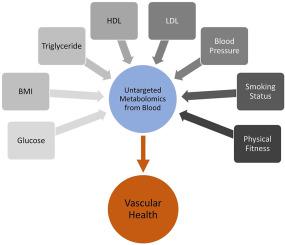Atherosclerosis ( IF 5.3 ) Pub Date : 2021-07-13 , DOI: 10.1016/j.atherosclerosis.2021.07.005 Lukas Streese 1 , Anna Maria Springer 2 , Arne Deiseroth 1 , Justin Carrard 1 , Denis Infanger 1 , Christoph Schmaderer 3 , Arno Schmidt-Trucksäss 1 , Tobias Madl 4 , Henner Hanssen 1

|
Background and aims
An untargeted metabolomics approach allows for a better understanding and identification of new candidate metabolites involved in the etiology of vascular disease. We aimed to investigate the associations of cardiovascular (CV) risk factors with the metabolic fingerprint and macro- and microvascular health in an untargeted metabolomic approach in predefined CV risk groups of aged individuals.
Methods
The metabolic fingerprint and the macro- and microvascular health from 155 well-characterized aged (50–80 years) individuals, based on the EXAMIN AGE study, were analysed. Nuclear magnetic resonance spectroscopy was used to analyse the metabolic fingerprint. Carotid-femoral pulse wave velocity and retinal vessel diameters were assessed to quantify macro- and microvascular health.
Results
The metabolic fingerprint became more heterogeneous with an increasing number of risk factors. There was strong evidence for higher levels of glutamine [estimate (95% CI): −14.54 (−17.81 to −11.27), p < 0.001], glycine [−5.84 (−7.88 to −3.79), p < 0.001], histidine [−0.73 (−0.96 to −0.50), p < 0.001], and acetate [−1.68 (−2.91 to −0.46), p = 0.007] to be associated with a lower CV risk profile. Tryptophan, however, was positively associated with higher CV risk [0.31 (0.06–0.56), p = 0.015]. The combination of a priori defined CV risk factors explained up to 45.4% of the metabolic variation. The metabolic fingerprint explained 20% of macro- and 23% of microvascular variation.
Conclusions
Metabolic profiling has the potential to improve CV risk stratification by identifying new underlying metabolic pathways associated with atherosclerotic disease development, from cardiovascular risk to metabolites, to vascular end organ damage.
中文翻译:

代谢分析将心血管风险和血管终末器官损伤联系起来
背景和目标
非靶向代谢组学方法可以更好地理解和鉴定与血管疾病病因相关的新候选代谢物。我们旨在通过非靶向代谢组学方法在老年人的预定义 CV 风险组中研究心血管 (CV) 风险因素与代谢指纹和大血管和微血管健康之间的关联。
方法
分析了基于 EXAMIN AGE 研究的 155 名特征明确的老年(50-80 岁)个体的代谢指纹以及大血管和微血管健康状况。核磁共振光谱用于分析代谢指纹。评估颈股脉搏波速度和视网膜血管直径以量化宏观和微血管健康。
结果
随着风险因素数量的增加,代谢指纹变得更加异质。有强有力的证据表明谷氨酰胺水平较高 [估计 (95% CI):-14.54(-17.81 至 -11.27),p < 0.001],甘氨酸 [-5.84(-7.88 至 -3.79),p < 0.001],组氨酸[-0.73(-0.96 至 -0.50),p < 0.001] 和醋酸盐 [-1.68(-2.91 至 -0.46),p = 0.007] 与较低的心血管风险状况相关。然而,色氨酸与较高的心血管风险呈正相关 [0.31 (0.06–0.56), p = 0.015]。先验定义的 CV 风险因素的组合解释了高达 45.4% 的代谢变异。代谢指纹解释了 20% 的宏观和 23% 的微血管变异。
结论
代谢分析有可能通过识别与动脉粥样硬化疾病发展相关的新的潜在代谢途径来改善心血管风险分层,从心血管风险到代谢物,再到血管终末器官损伤。


























 京公网安备 11010802027423号
京公网安备 11010802027423号